BIO-249 Lecture Exam 6: Cell Signaling & Endocrine System
1/27
There's no tags or description
Looks like no tags are added yet.
Name | Mastery | Learn | Test | Matching | Spaced |
|---|
No study sessions yet.
28 Terms
Gap Junction Definition
shortest distance signaling
Cells have to be RIGHT NEXT to each other
Chemicals, proteins, & signal molecules simply diffuse across them
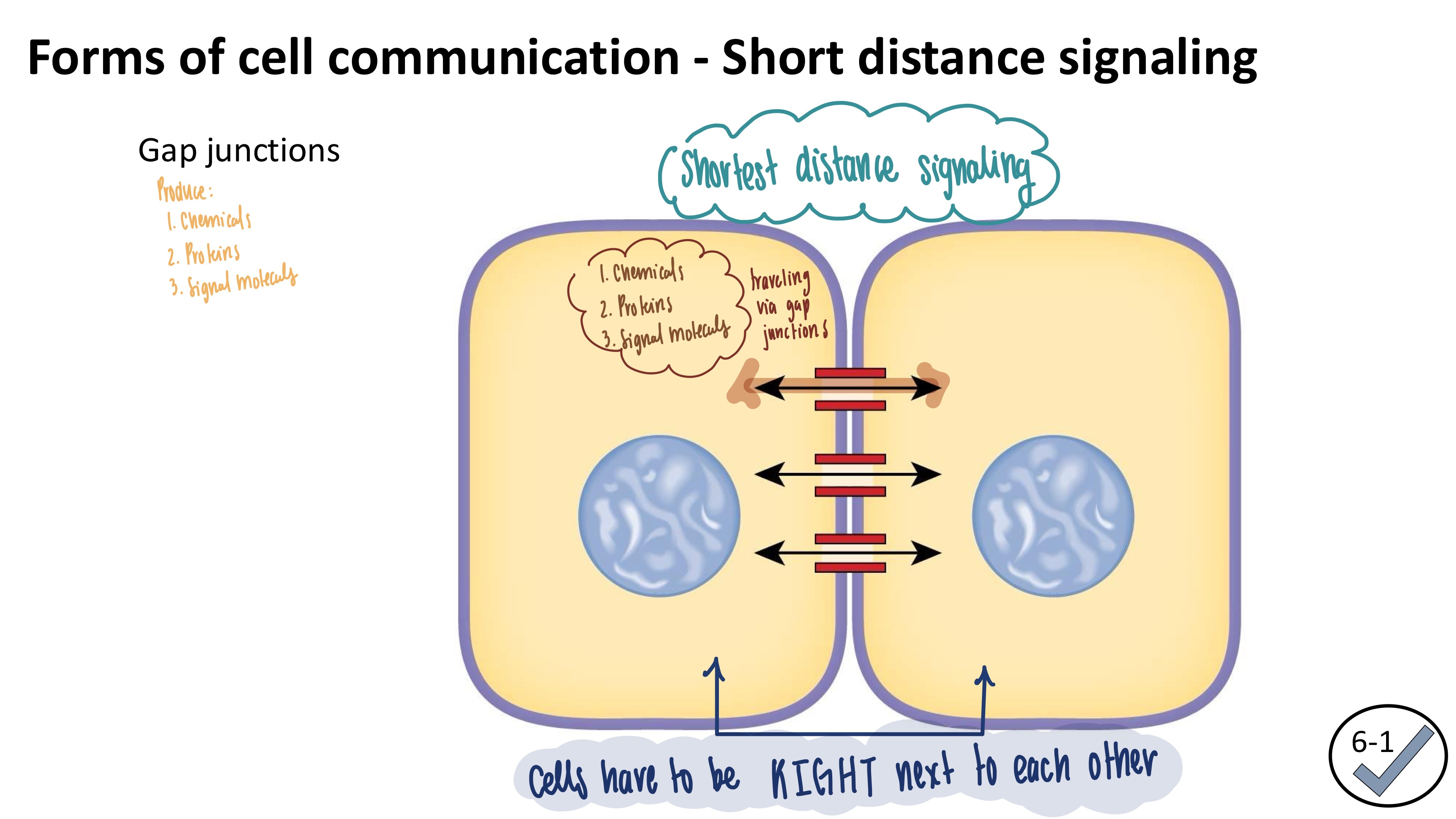
Contact Signaling Definition
using membrane proteins as a receptor AND ligand
the first membrane protein (ligand) binds to the receptor’s active site to create a response
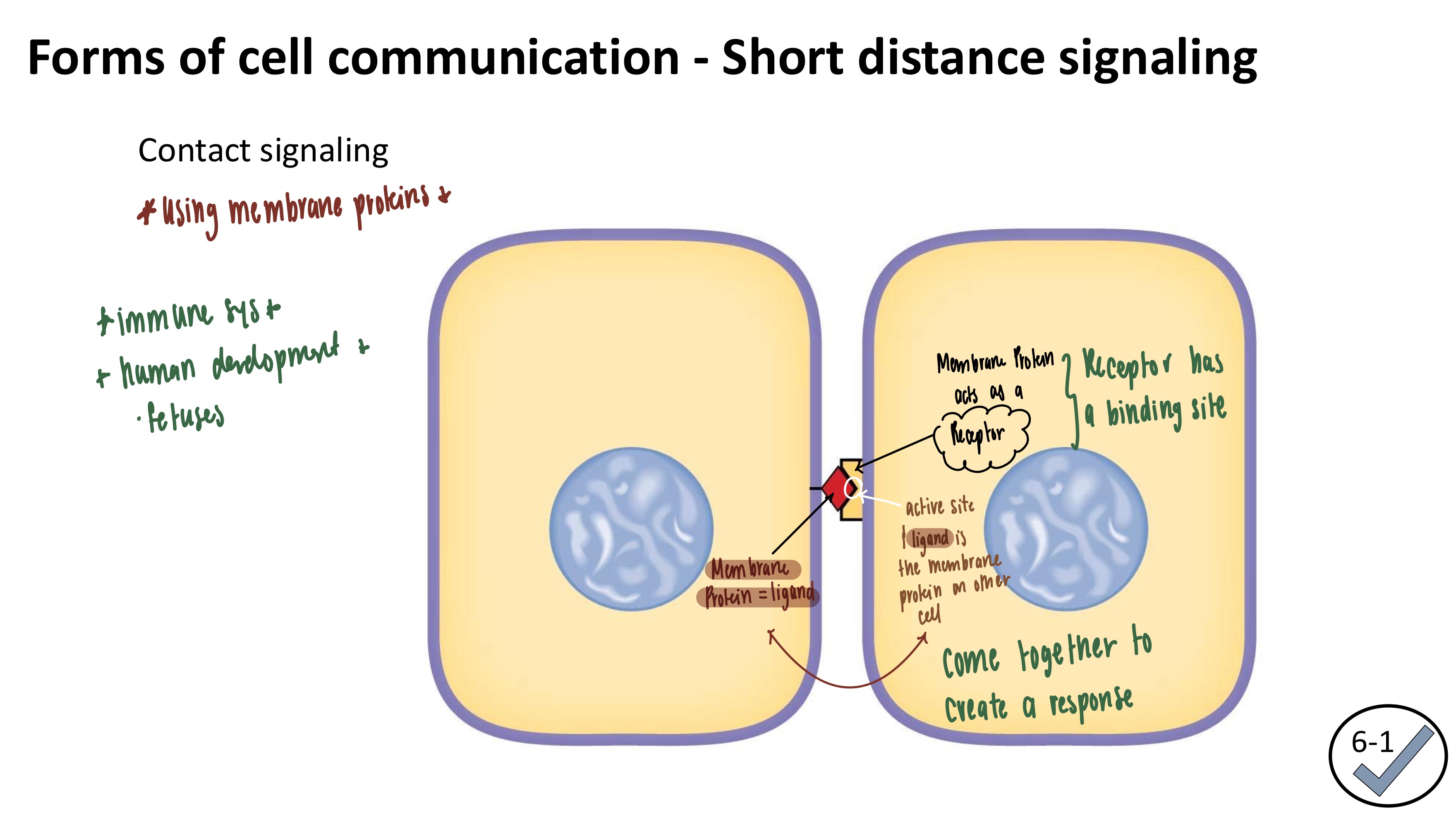
Autocrine/Paracrine Signaling Definition
Similarities:
SHORT DISTANCE
BOTH secrete lots of signaling molecules that bind to receptors
BOTH heavily rely on diffusion! which limits the signaling distance to the local level
Autocrine Signaling: cell sends signal to ITSELF
Paracrine Signaling: cell releases signal molecules to NEARBY cells
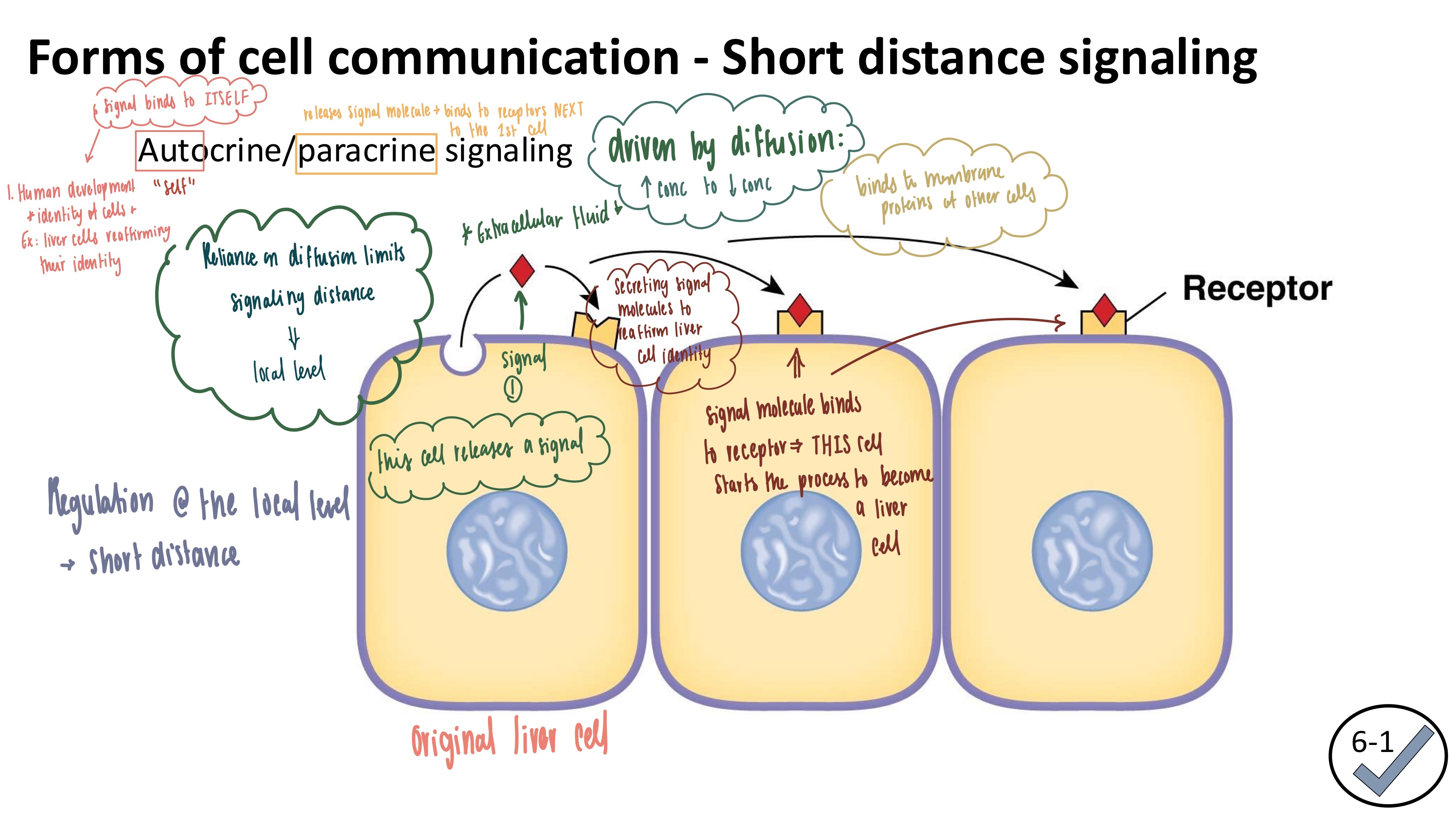
Hormone/Endocrine Signaling
LONG-DISTANCING signaling
Endocrine Cell RELEASES chemical signal to the bloodstream
Chemical signal in the bloodstream → hormone
Hormone binds to the receptors on the target cells
Target cells NEED the receptor for the response, if they don’t have it
Response is created
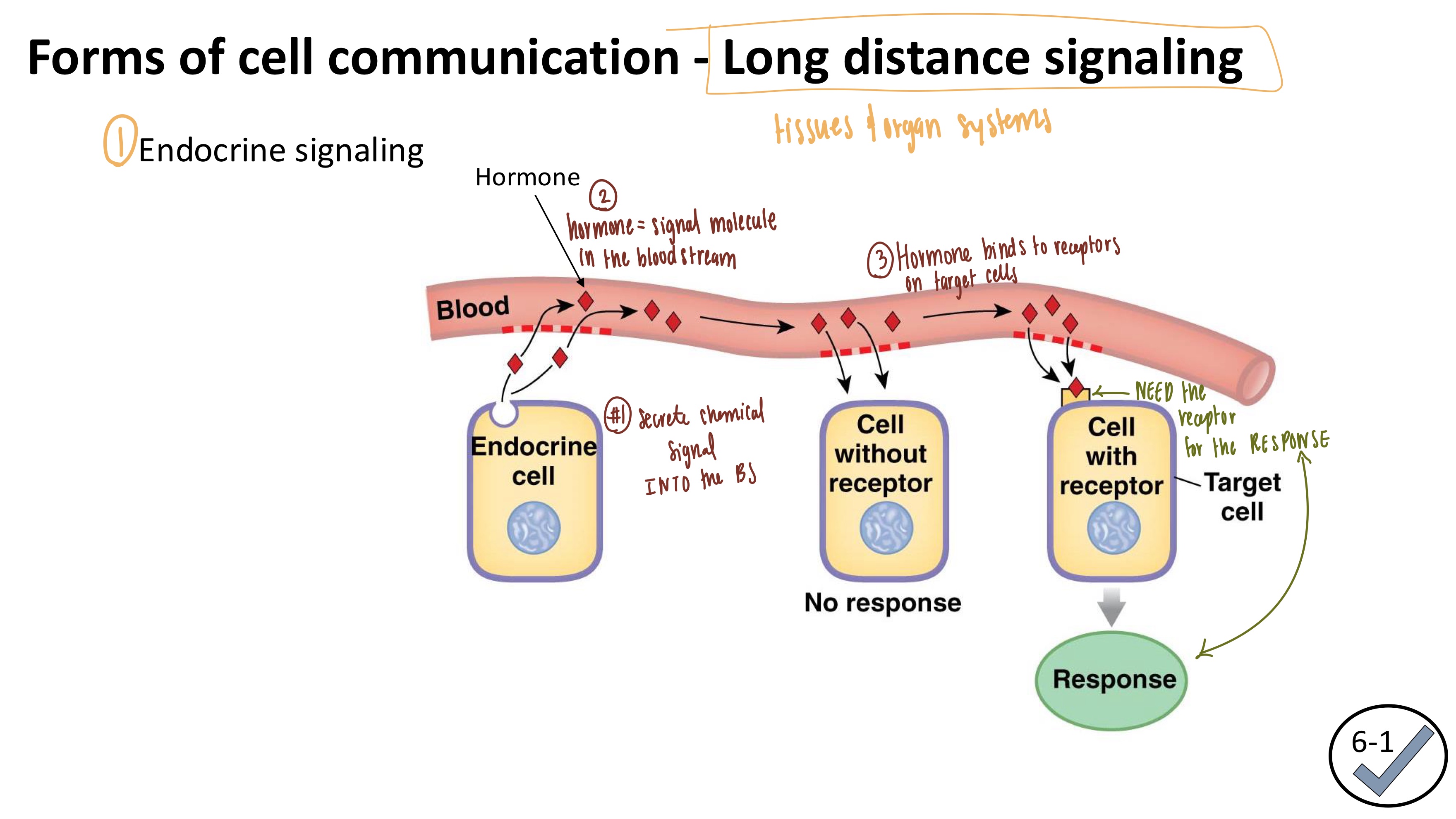
Neurotransmitter Signaling
LONG-DISTANCING SIGNALING
Electrical signal reaches the axon terminal
Axon terminal RELEASES neurotransmitters
Neurotransmitters bind to receptors & send commands to the target cell (postsynaptic cell)
Response is created

Neurohormone Signaling
LONG-DISTANCE Signaling
Electrical signal travels down the neuron (neuro part)
Axon terminal secretes neurotransmitter into the bloodstream (hormone part)
Hormone goes down the bloodstream (acts like a hormone)
Hormone interacts with the target cells
Response is created
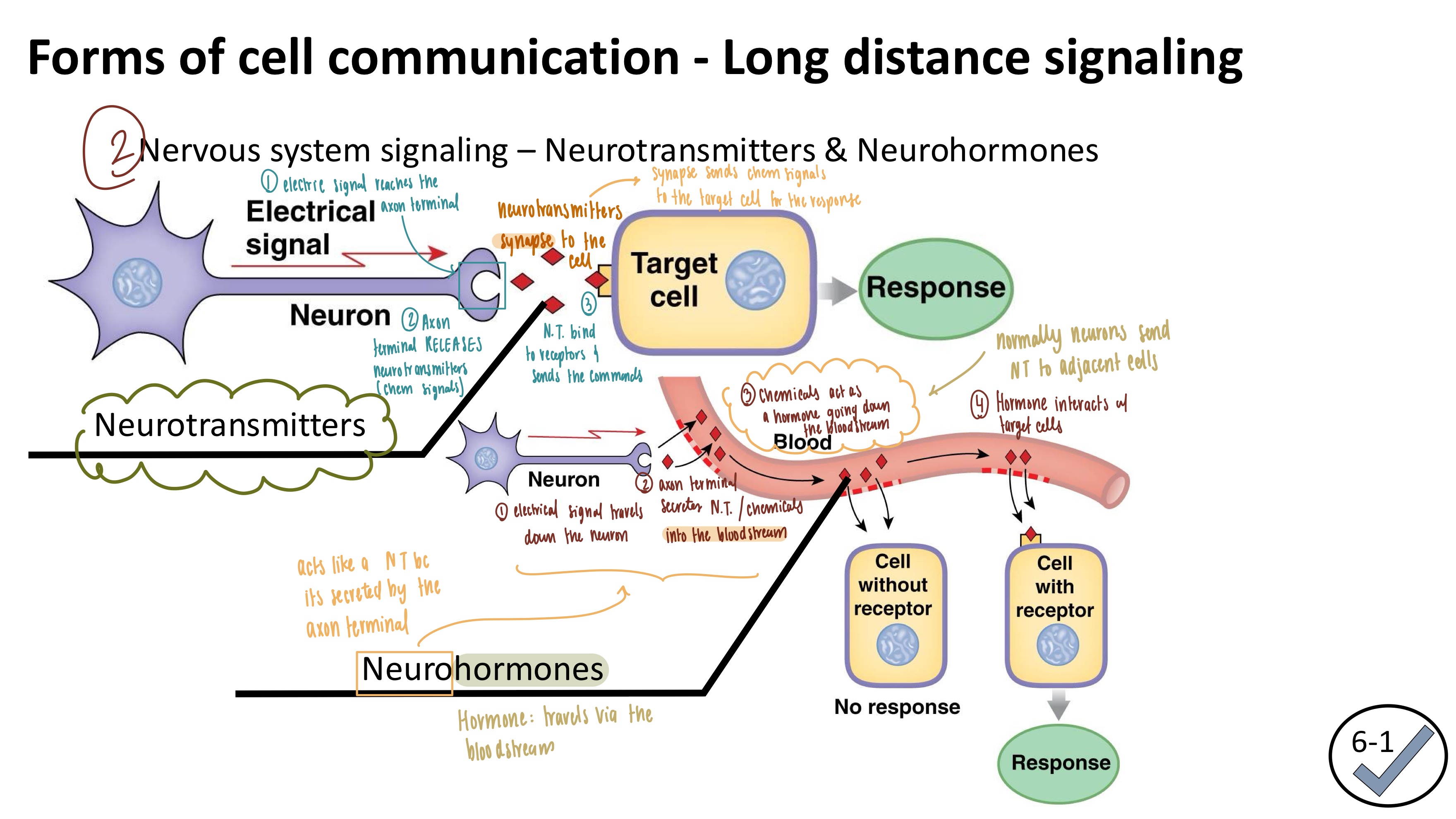
Cell Communication Summary
SHORT DISTANCE
Gap Junction
Contact Signaling
Autocrine
Paracrine
LONG DISTANCE
Endocrine/Hormone
Nervous system Signaling
Neurotransmitters
Neurohormones
What kind of responses can you expect to get from a chemical signal?
What kind of cellular processes can chemical signals regulate?
Chemical Signal RESPONSES
Enzyme activity: working more efficiently or shutting them off
Membrane proteins
opening/closing them
Gene Activity: creating new proteins
Cellular Processes Regulated
Homeostasis
Reproduction
Growth
Development
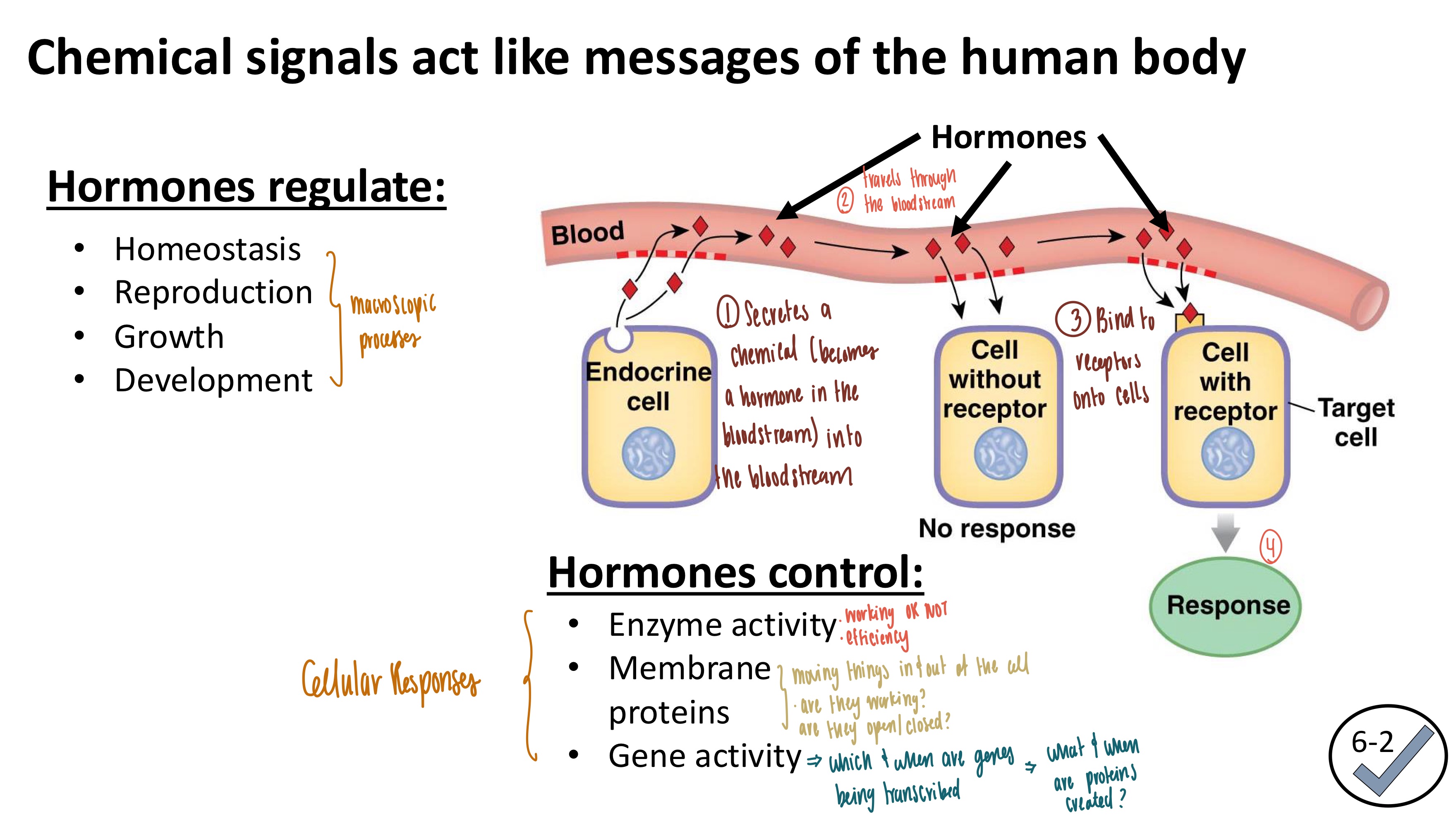
Describe the generalized signal pathway.
Given a signal molecule, what events occur from the time the signal binds with the receptor to the target cell’s response?
Signal Molecule/Ligand binds to membrane receptor protein
signal molecule/ligand = first messenger (outside the cell)
Ligand & receptor protein activate intracellular (within the cell) signal molecules
Intracellular signal molecules alter target proteins
Intracellular signal molecules are the second messenger system
Target proteins create a response
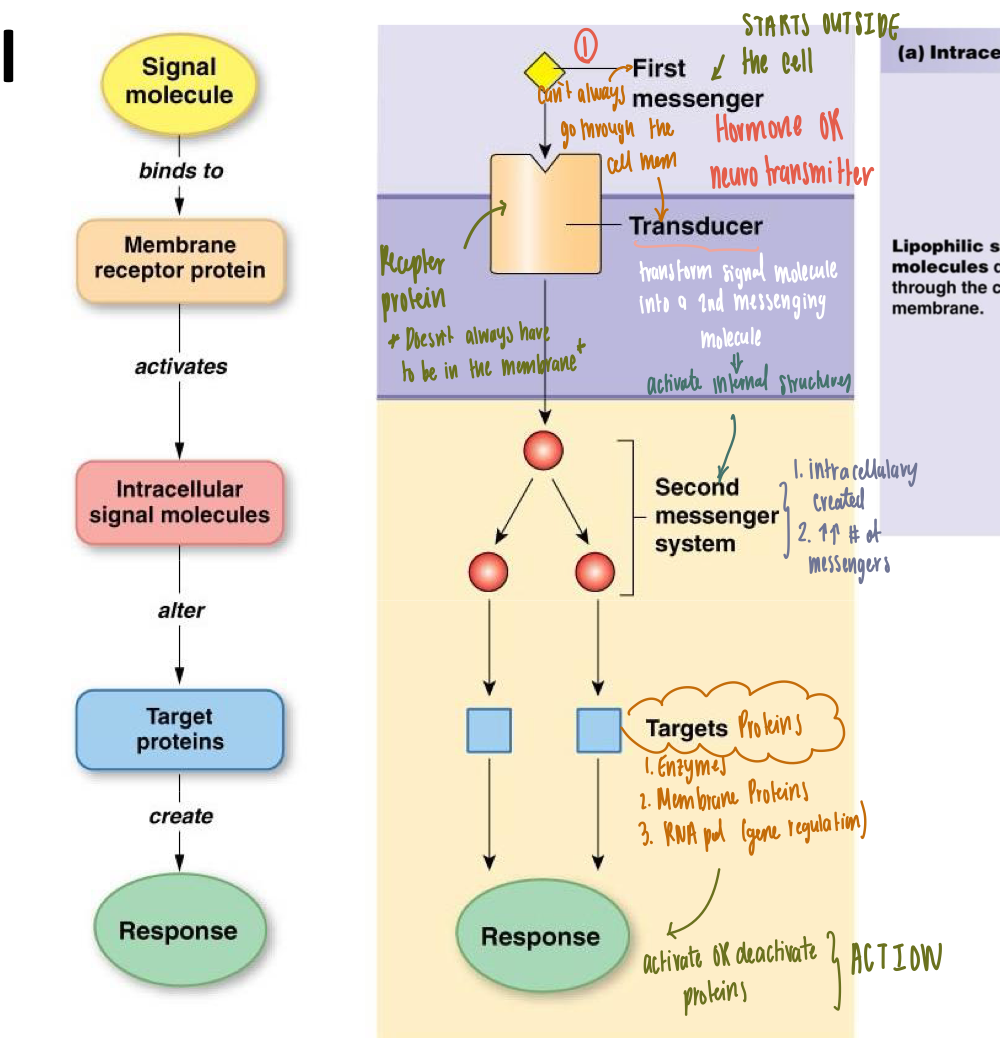
What are second messengers?
Intracellular (within the cell) signal molecules that alter target proteins
Quickly spread out throughout the cell via diffusion
Where are two places in the cell where can we find receptors for chemical signals?
Extracellularly (on the cell membrane)
Signal molecules/ligands: proteins because they’re too big
Intracellularly (inside the cell membrane)
Signal molecules/ligands: lipids because they can diffuse through the cell membrane
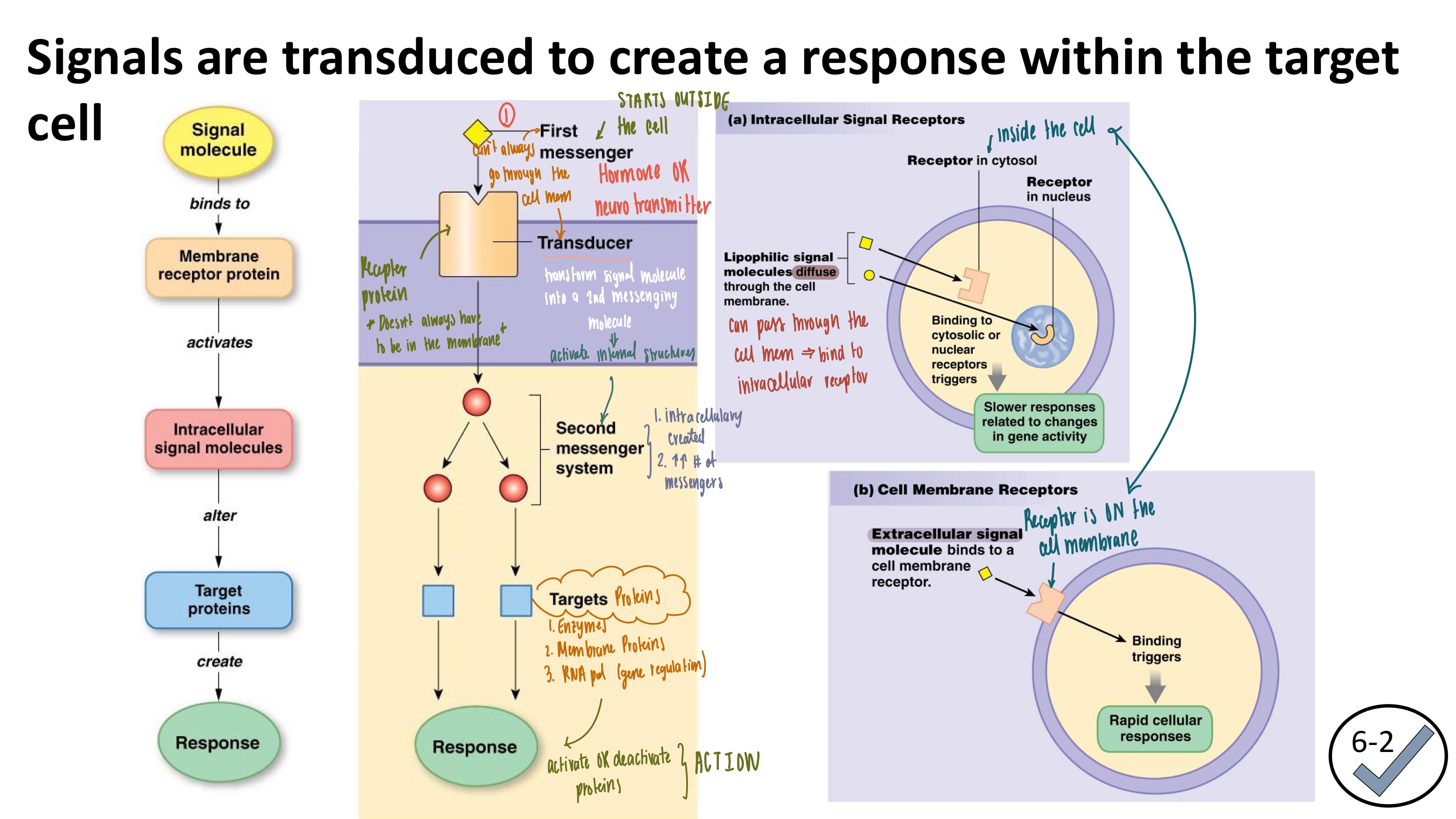
What are the two chemically different groups of hormones in the human body? Describe the characteristics of each group. Note: see the table in the lecture slides.
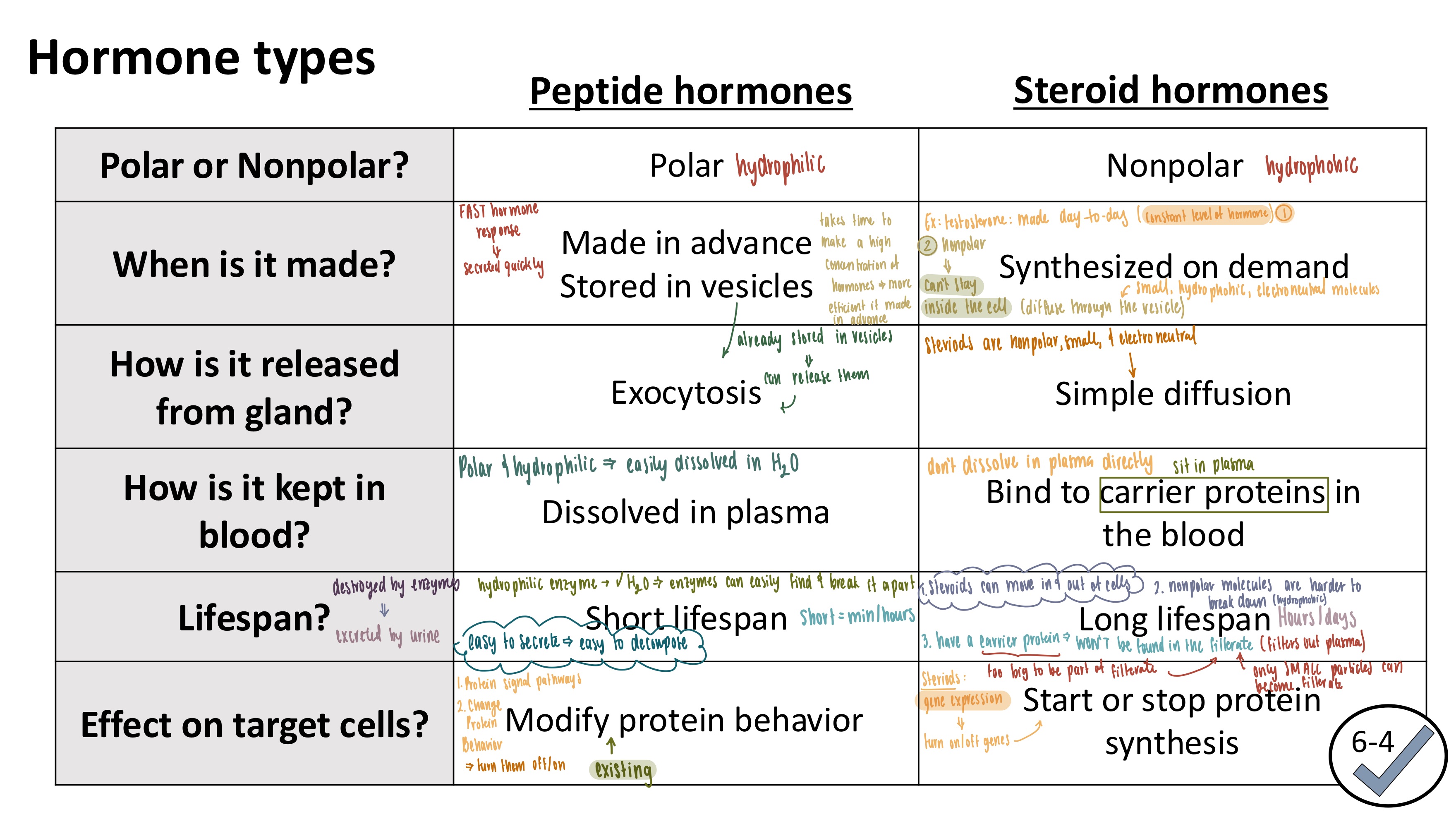
How do hydrophilic hormones trigger a cell response?
Where are the receptors?
How do the receptors lead to a response?
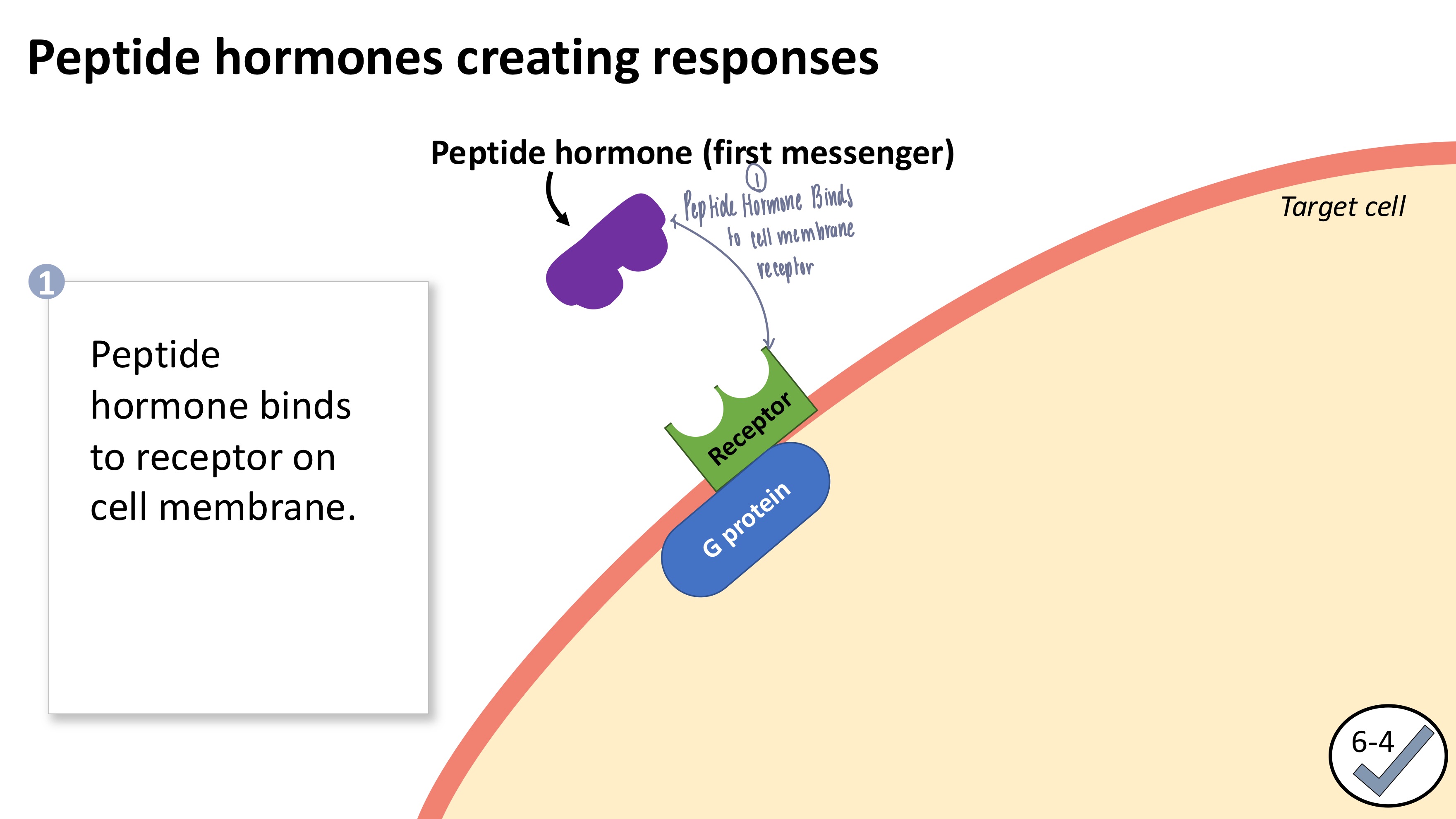
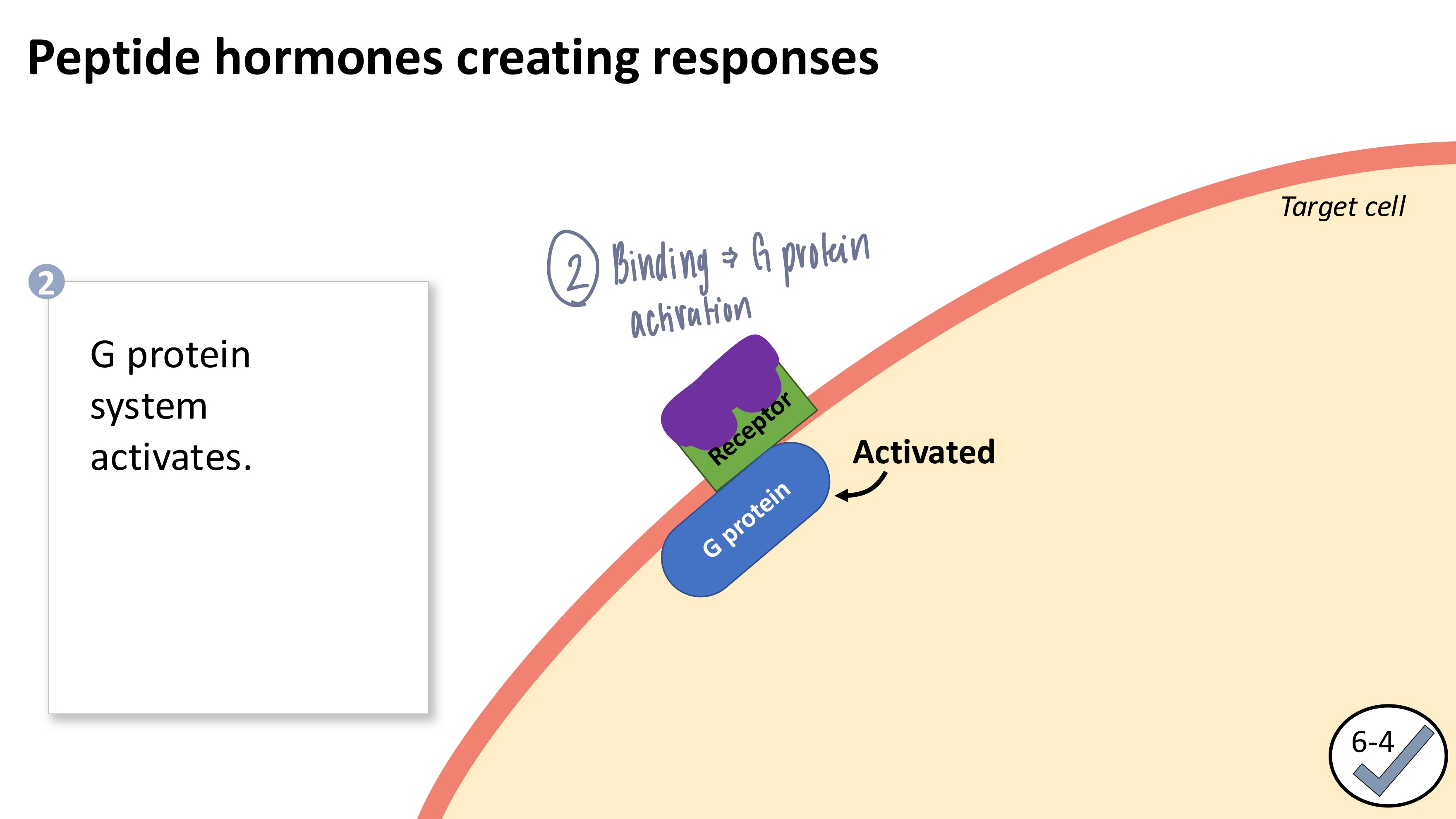
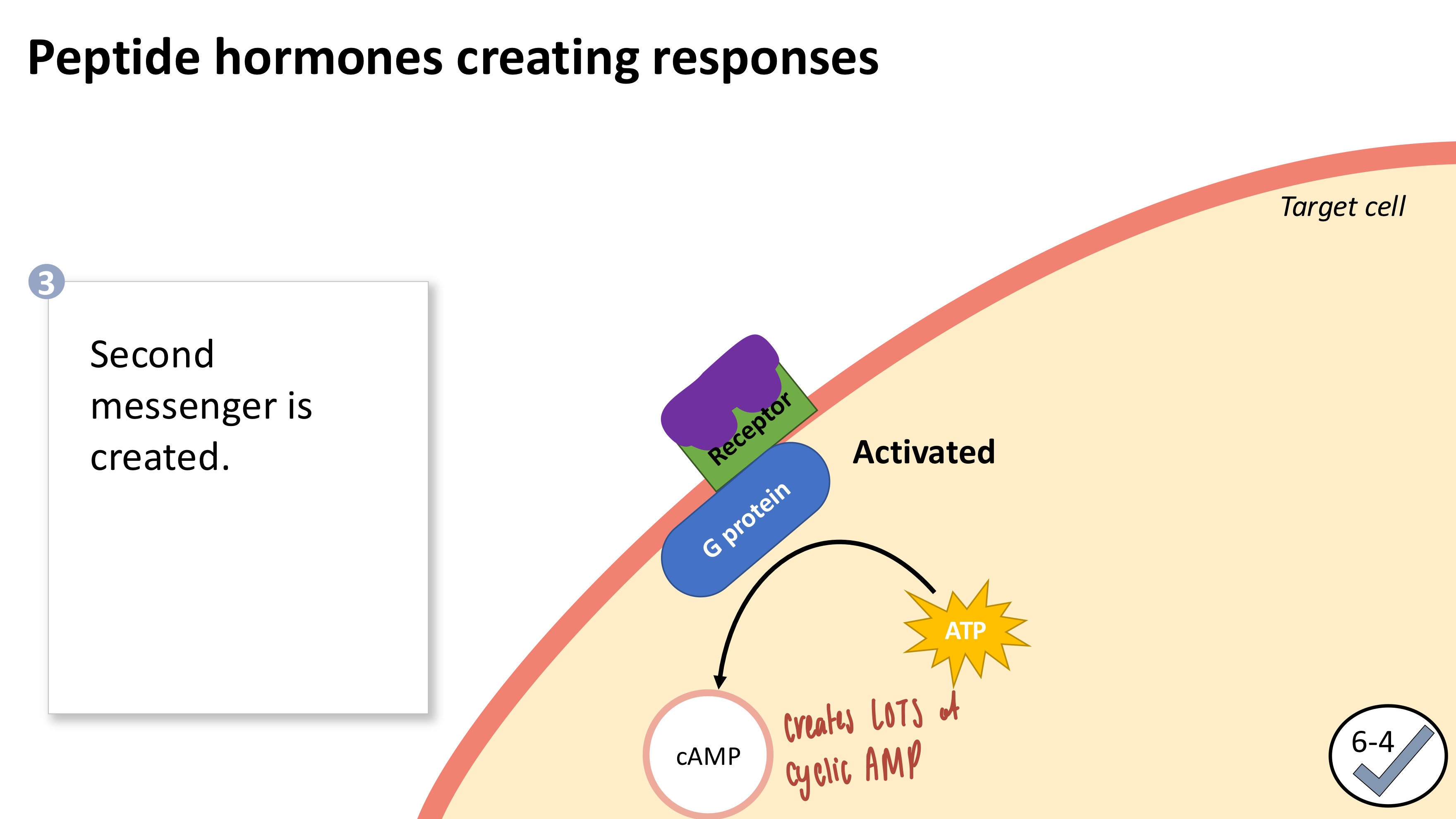
Peptide hormone (first messenger) binds to the receptor on the cell membrane
G protein system activates
Second messenger is created
Second messenger changes protein activity
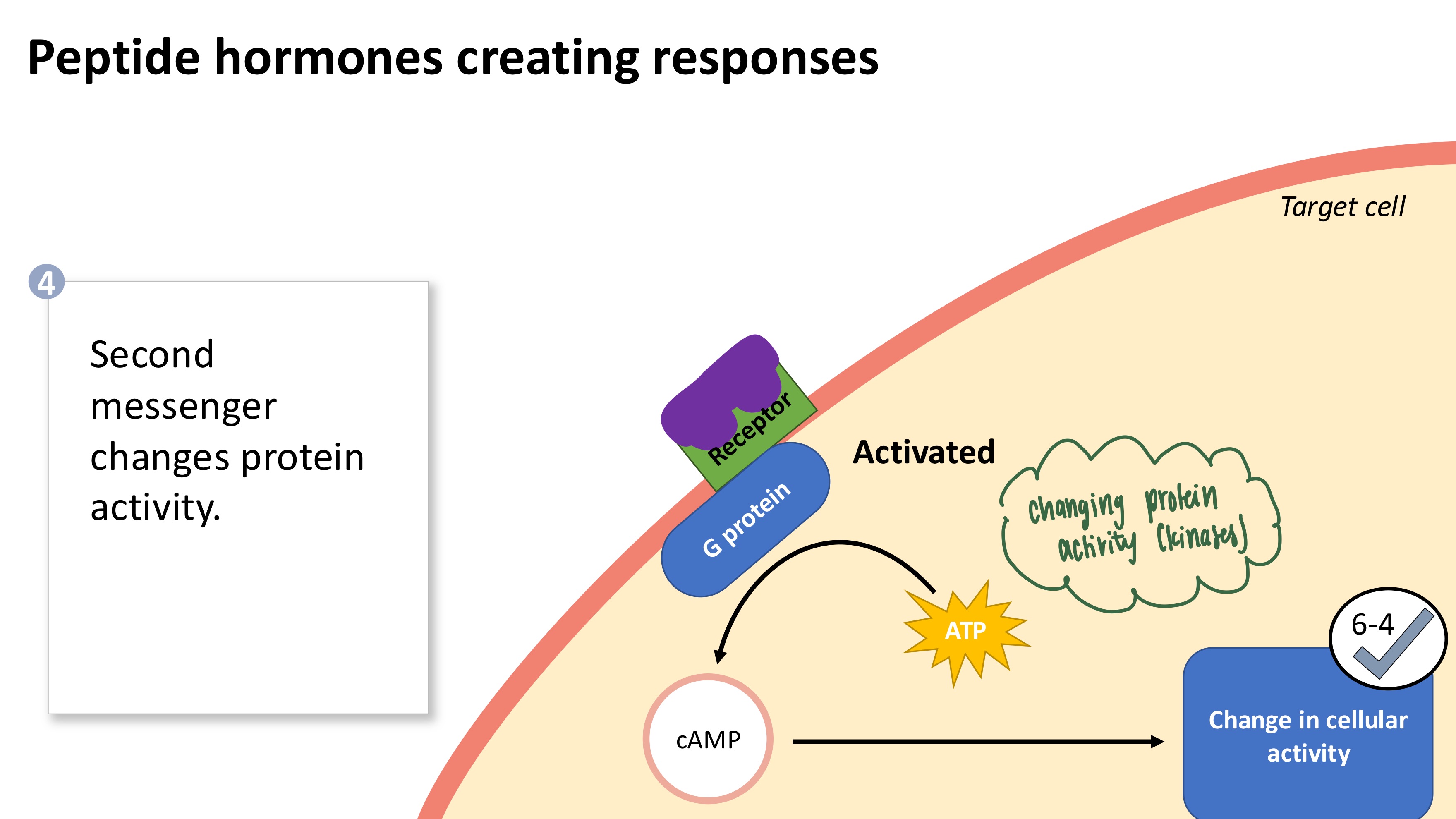
How do hydrophobic hormones trigger a cell response?
Where are the receptors?
How do the receptors lead to a response?
Steroid hormone diffuses straight into the cell & binds to the intracellular receptor
Transduction occurs & gene expression starts or is altered
Transcription of DNA occurs, creating mRNA
Translation of mRNA creates protein, which leads to the alteration of cellular structure & activity
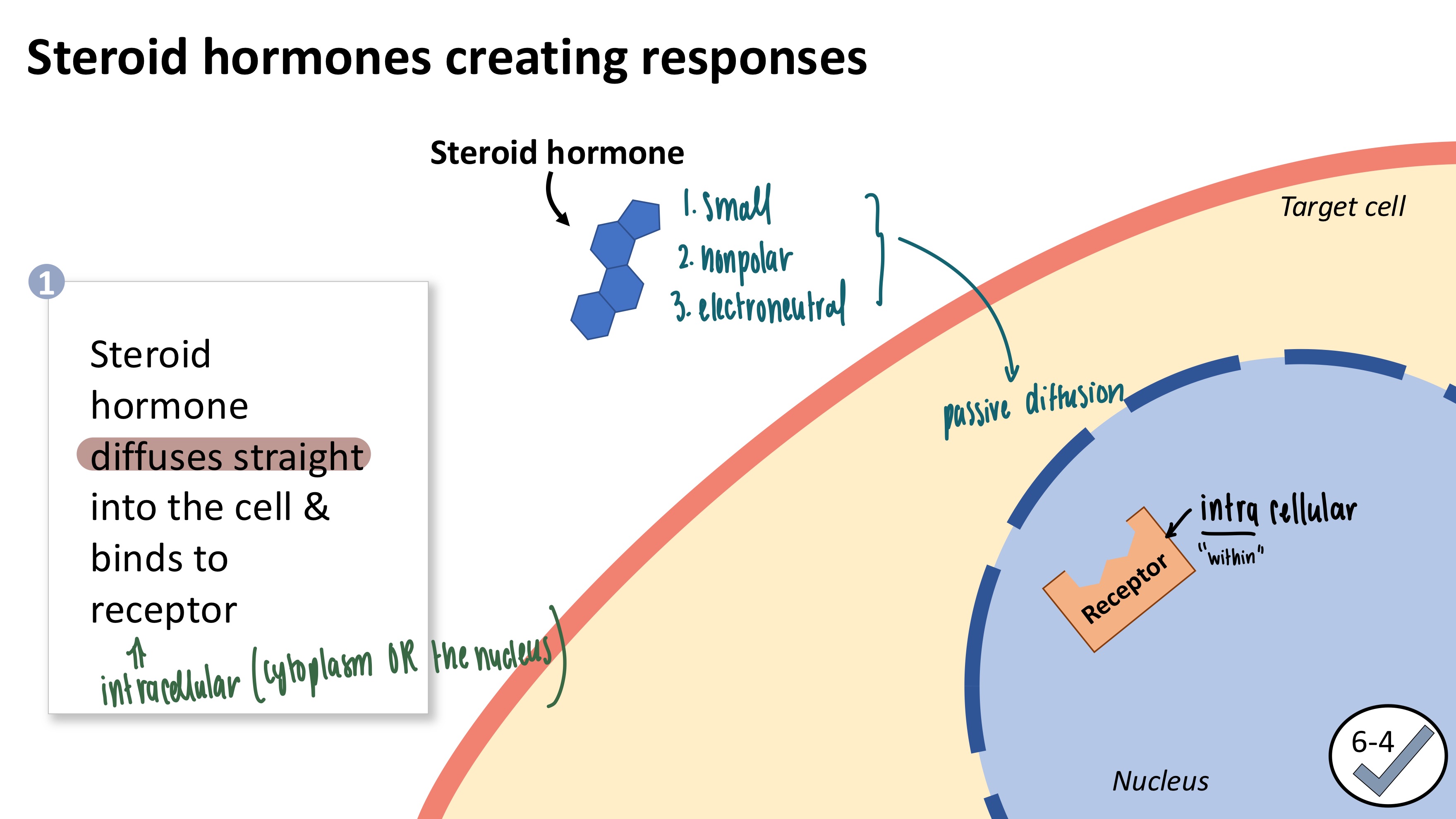
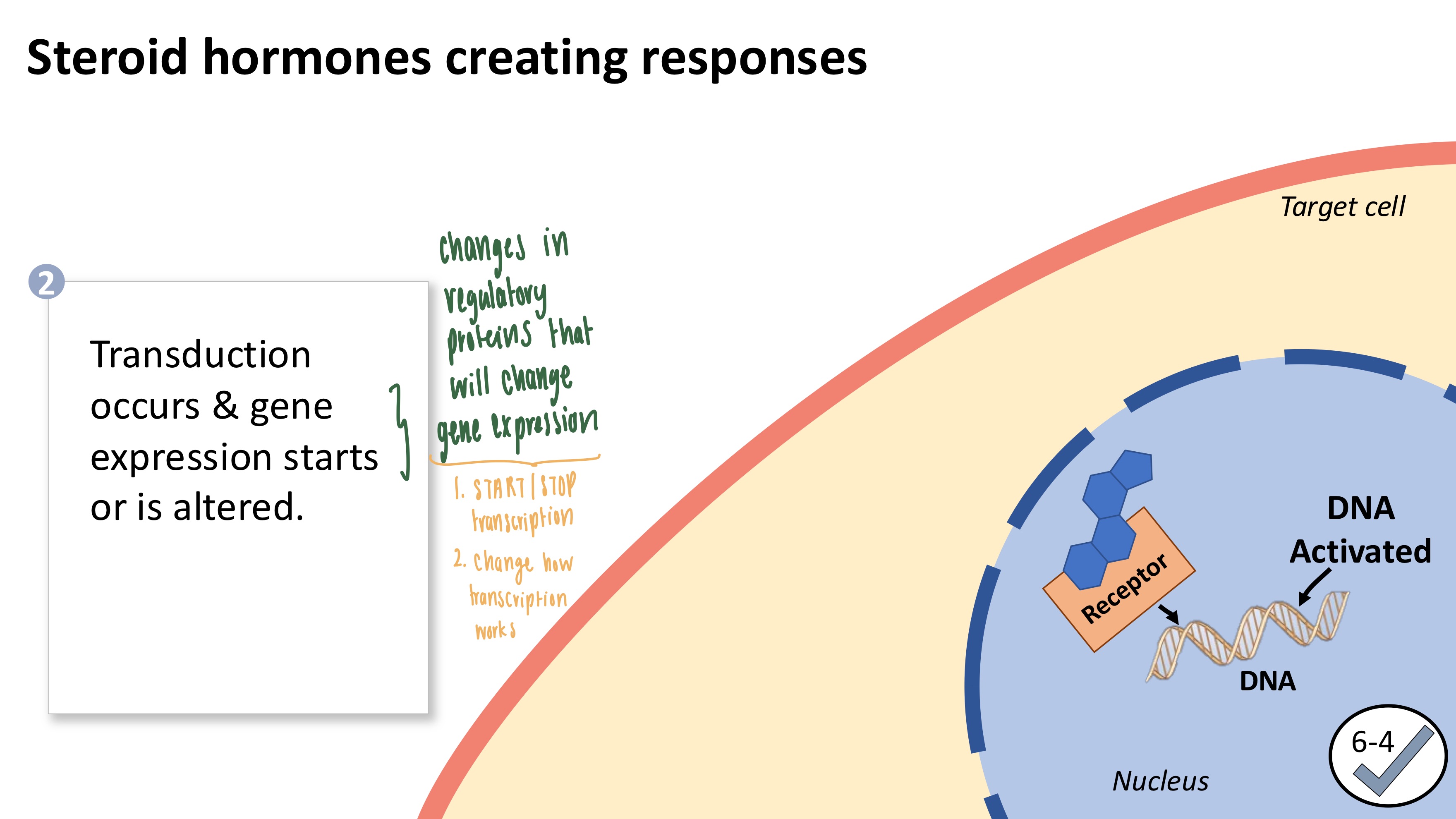
For hormone feedback loops, where is the receptor?
Receptor in endocrine eclls
Membrane protein receptors
Intracellular receptors
What is an efferent pathway, and what is it typically in a hormone feedback loop?
Efferent Pathway: how the control center relays info to the effectors using hormones
Hormone Feedback Loop Process
Stimulus:
humoral (blood)
neural (nervous system)
Hormonal (endocrine)
Receptor (on/in the endocrine cells)
Membrane Protein Receptors ON the cell membrane
Intracellular Receptors IN the cell
Control Center: endocrine cells
Efferent Pathway: hormones TRAVELING via the bloodstream
Effector: other cells and/or organs
Response: Long-term changes in cells
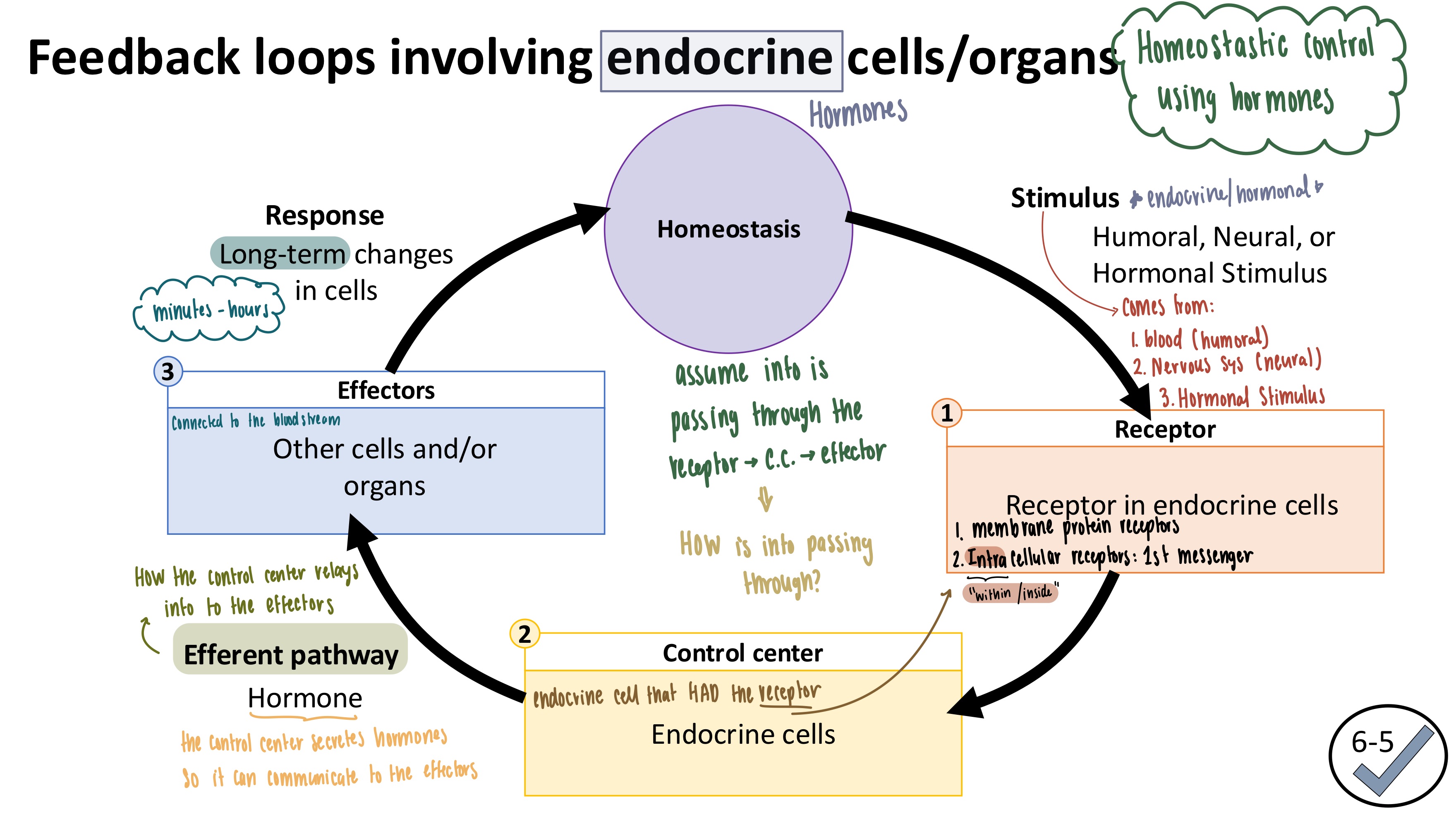
Describe how blood sugar (e.g., glucose plasma concentration) is regulated with insulin
Stimulus: Humoral- increase in blood sugar
Receptor: receptor in beta cells of pancreas
Control Center: Beta cells
signal pathway response: secrete insulin
Efferent Pathway: Insulin (secreted into the bloodstream)
Effectors
Liver
Other Cells
Response
Liver: Glycogenesis, creating glycogen from glucose
Other cells: intake of glucose
Overall: decrease in blood sugar
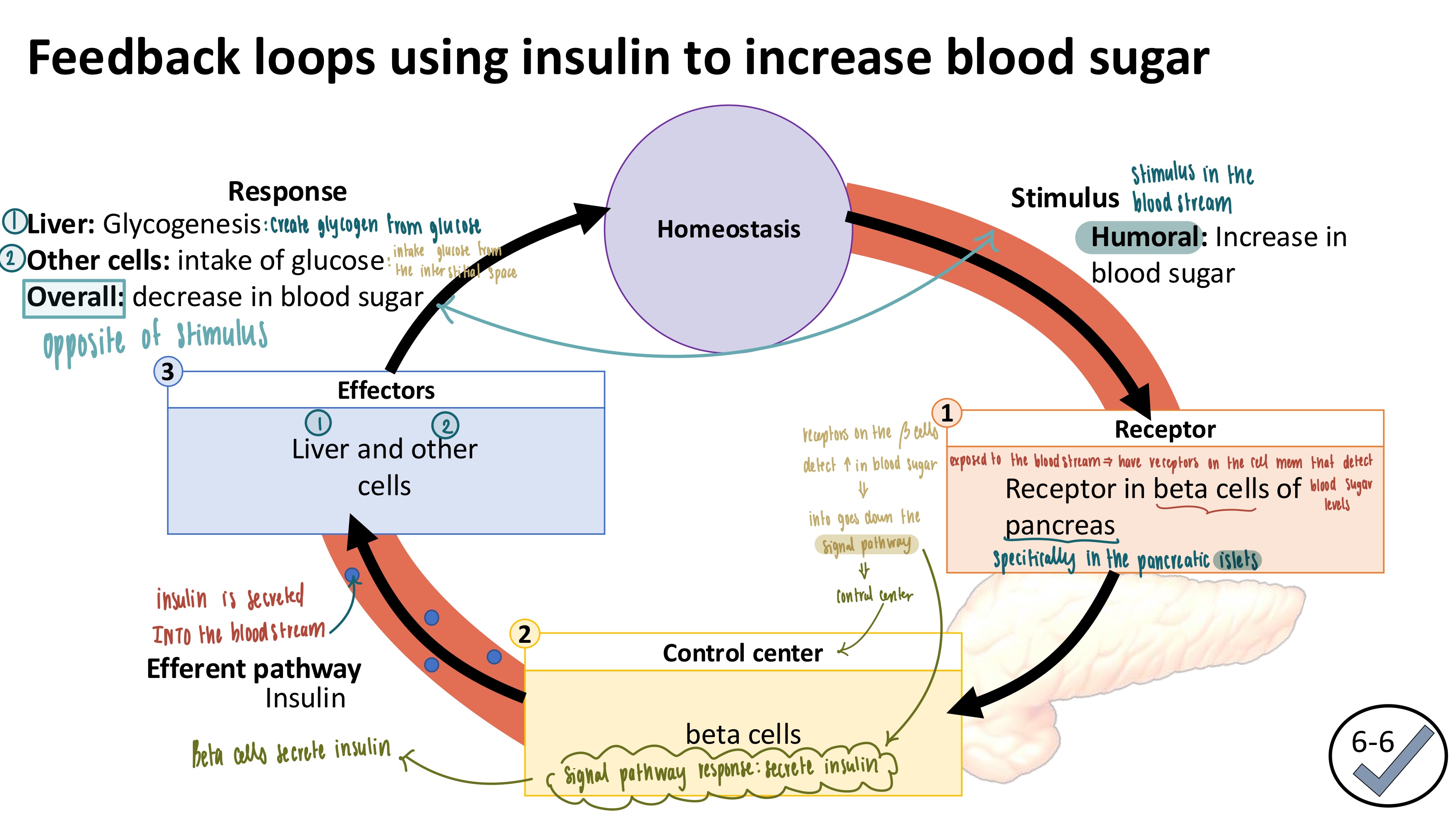
Describe how blood sugar (e.g., glucose plasma concentration) is regulated with the glucagon hormone
Stimulus: Humoral: decrease in blood sugar
Receptor: receptor in the alpha cells of the pancreas
Control Center: alpha cells
singal pathway response: secrete glucagon hormone
Efferent Pathway: Glucagon (travels via bloodstream)
Effector: Liver
Response
Liver: glycogenolysis, INCREASE in blood sugar
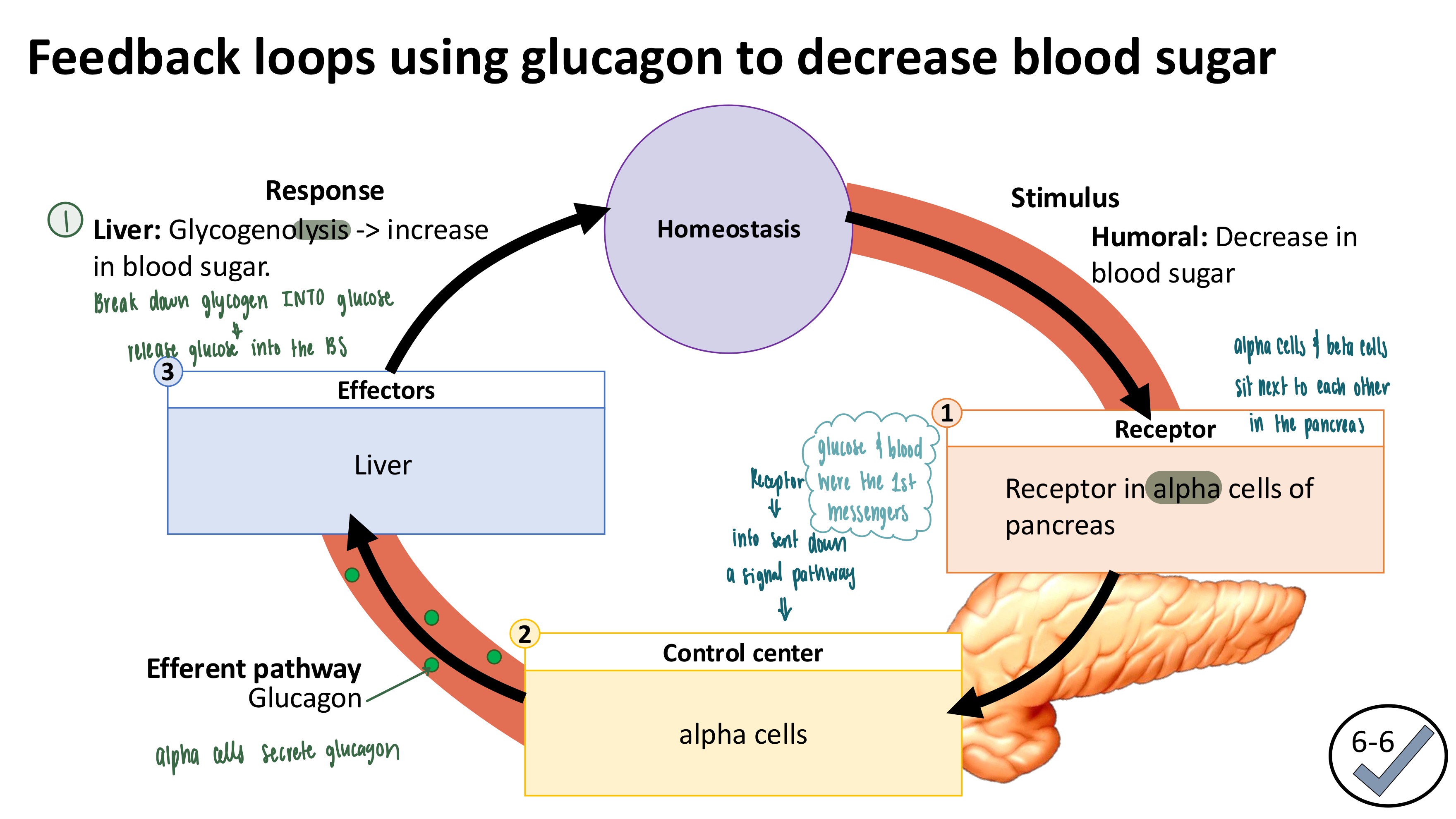
Insulin Issues
What will happen to plasma glucose levels if beta cells can’t make insulin?
What will happen to plasma glucose levels if other cells don’t respond to insulin?
Blood sugar remains high for both questions
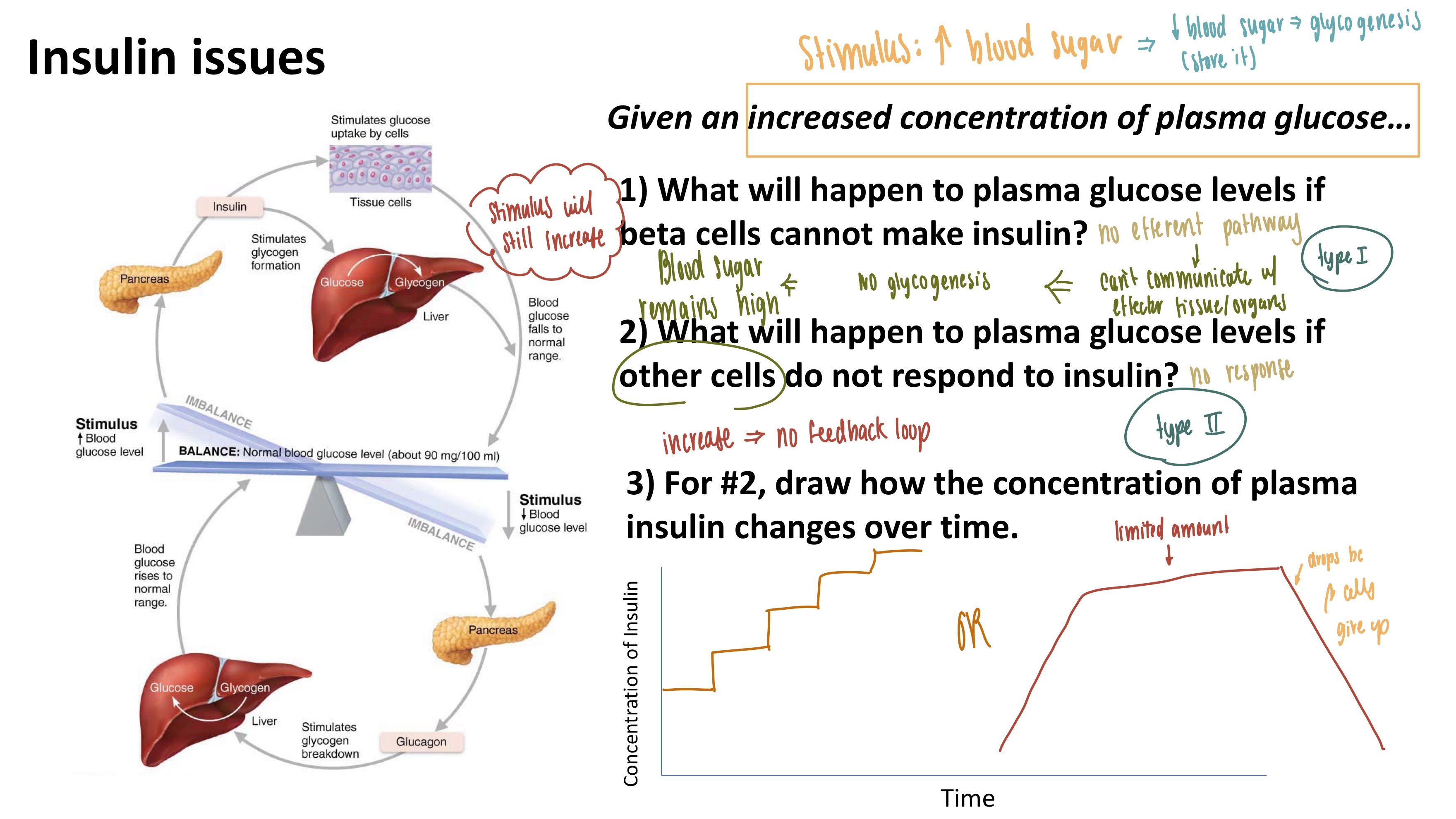
What is the vital function of Thyroxine?
Affects most cells in the body
Support development
Increase metabolic rate

Describe how the hypothalamus and anterior pituitary gland regulate thyroid hormone (a.k.a. Thyroxine). Make sure you include the following hormones: thyrotropin-releasing hormone (TRH), Thyroid-stimulating hormone (TSH).
Hypothalamus secretes thyrotropin-releasing hormone (TRH)
flows through the portal system until it reaches the Anterior pituitary gland
TRH will interact with the cells in the anterior pituitary gland → anterior pituitary gland secretes thyroid-stimulating hormone (TSH)
TSH flows OUT into the bloodstream & reaches the thyroid gland
The thyroid gland makes thyroxine (thyroid hormone- TH)
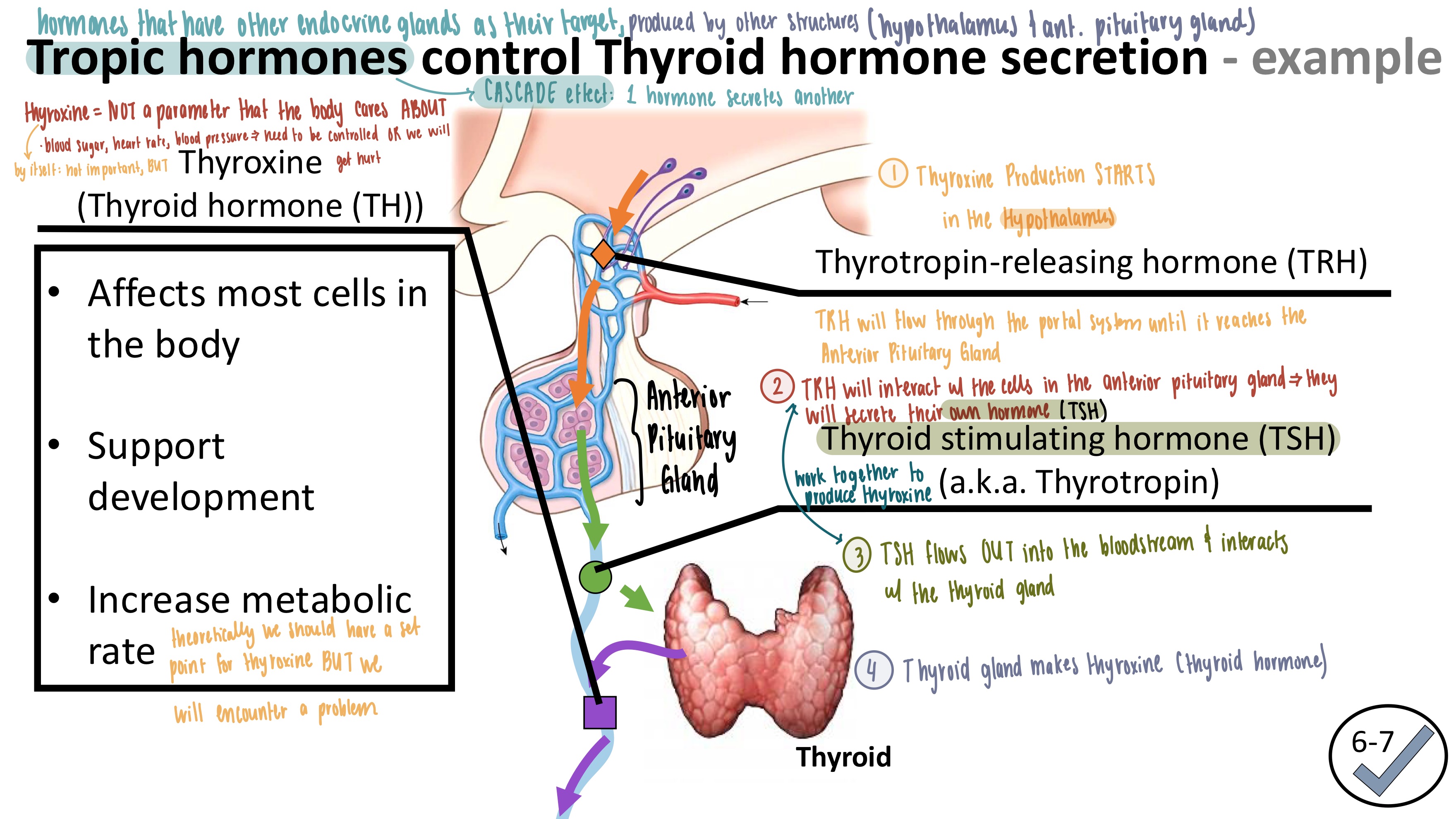
How does iodine deficiency creat Goiters (an enlarged thyroid)?
See pic!!
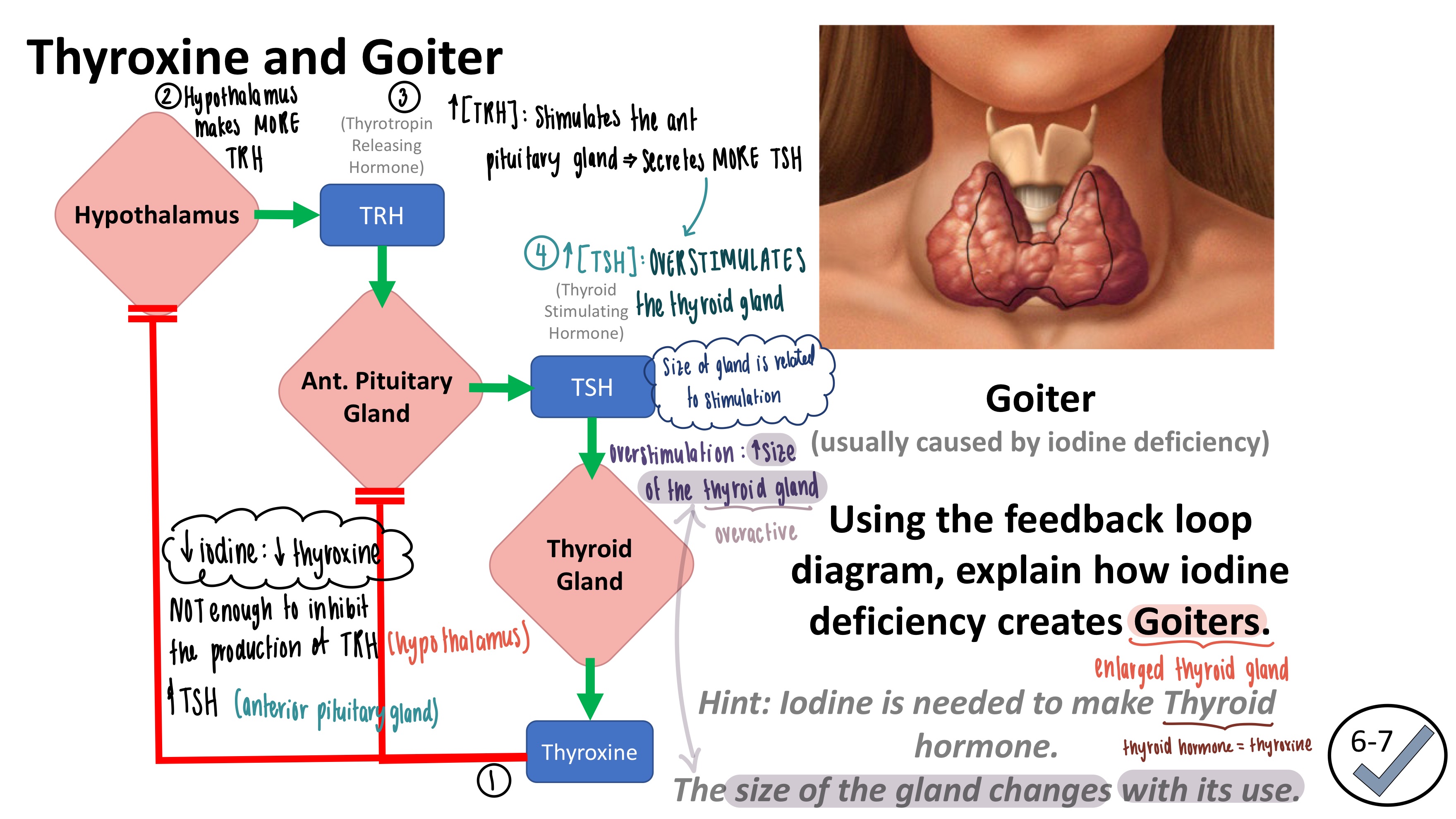
Be comfortable with the Thyroxine feedback loop to describe the effects of changing various feedback loop components.
Thyroid hormone (thyroxine) goes BACK to the hypothalamus & anterior pitutiary gland
TOO MUCH thyroxine inhibits the secretion of TRH at the hypothalamus & TSH at the anterior pituitary gland
TRH and TSH production decrease
Thyroxine production decreases
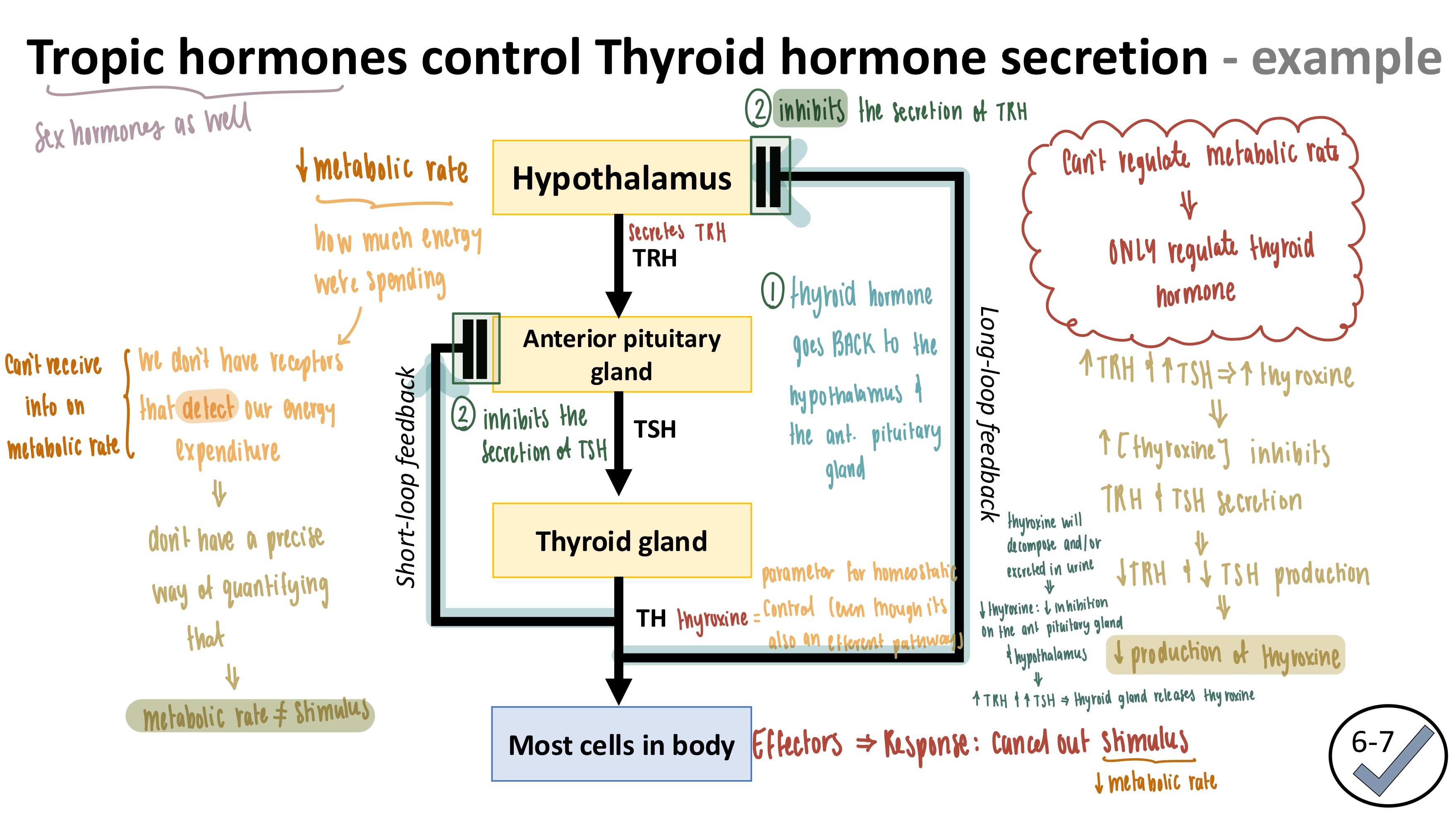
What happens when you add “exogeneous” testosterone?
Decrease body production of testosterone (see pic!)
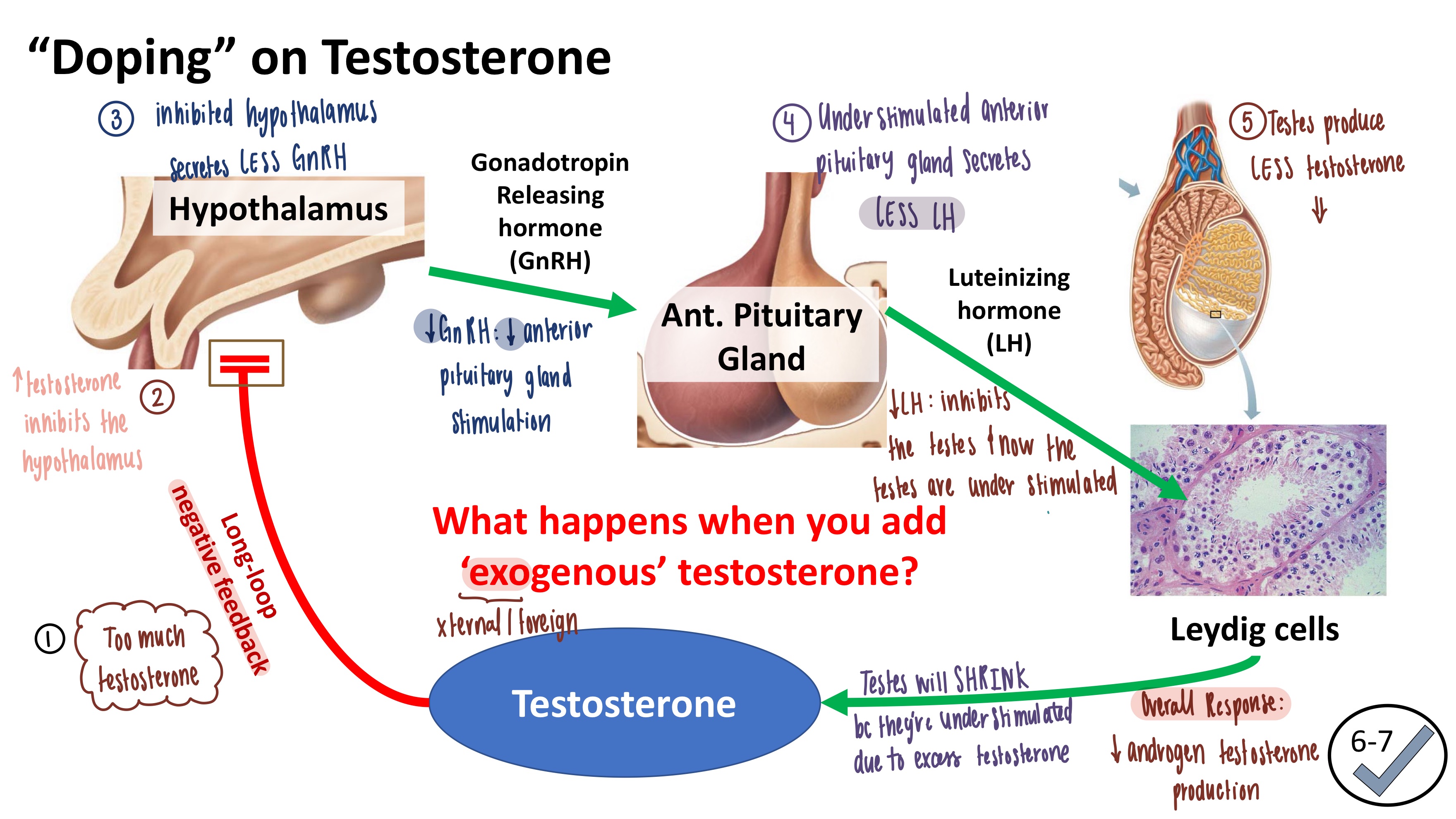
Antagonistic Hormone Interaction
Antagonistic: hormone responses are OPPOSITE of one another
increase insulin concentration, decrease glucagon concentration
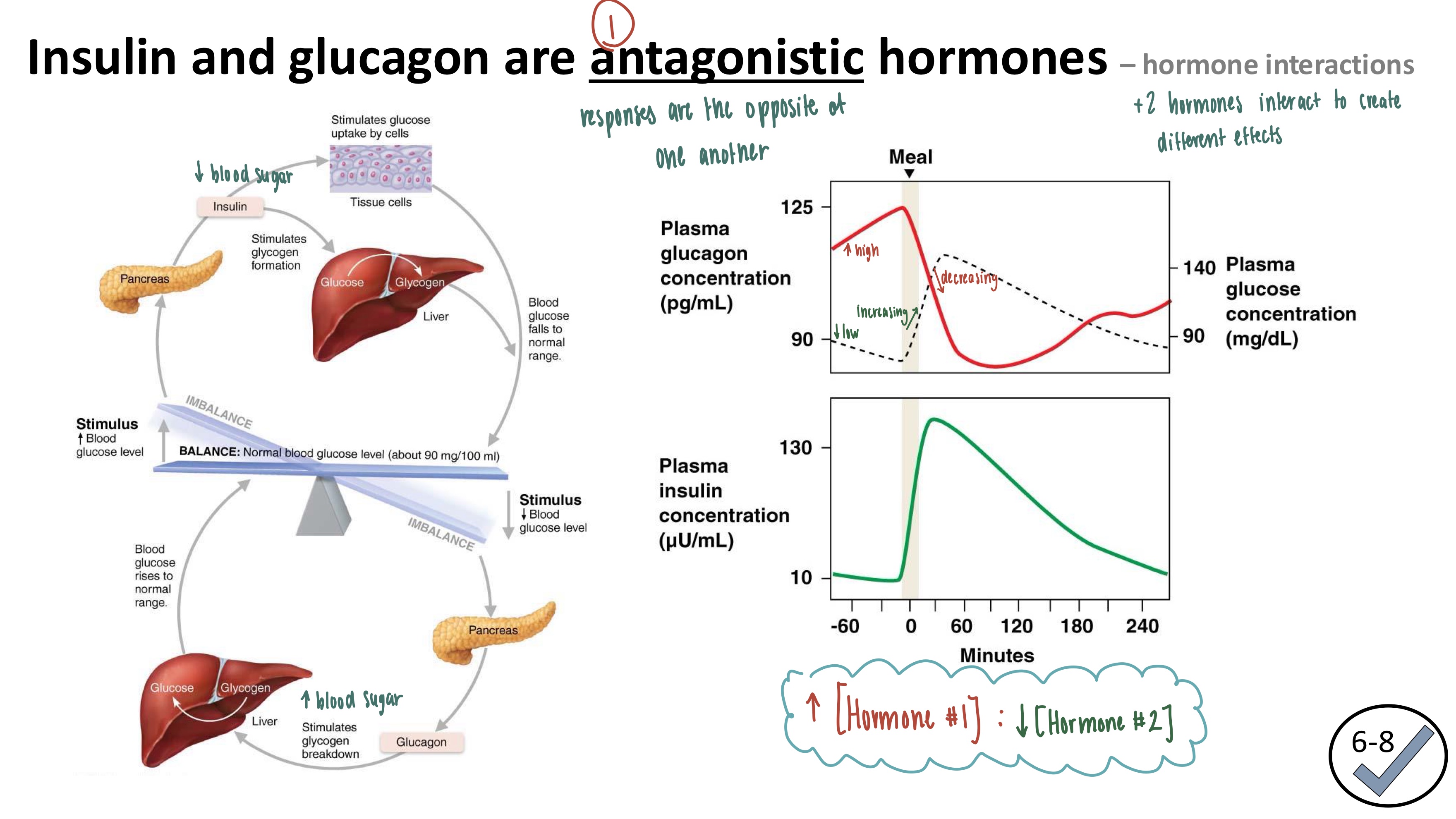
Permissive Hormone Interaction
Hormone A (thyroid hormone) gives “permission” to hormone B (sex hormone) to function
Sex hormones work by themselves, but work BETTER in the presence of thyroid hormone
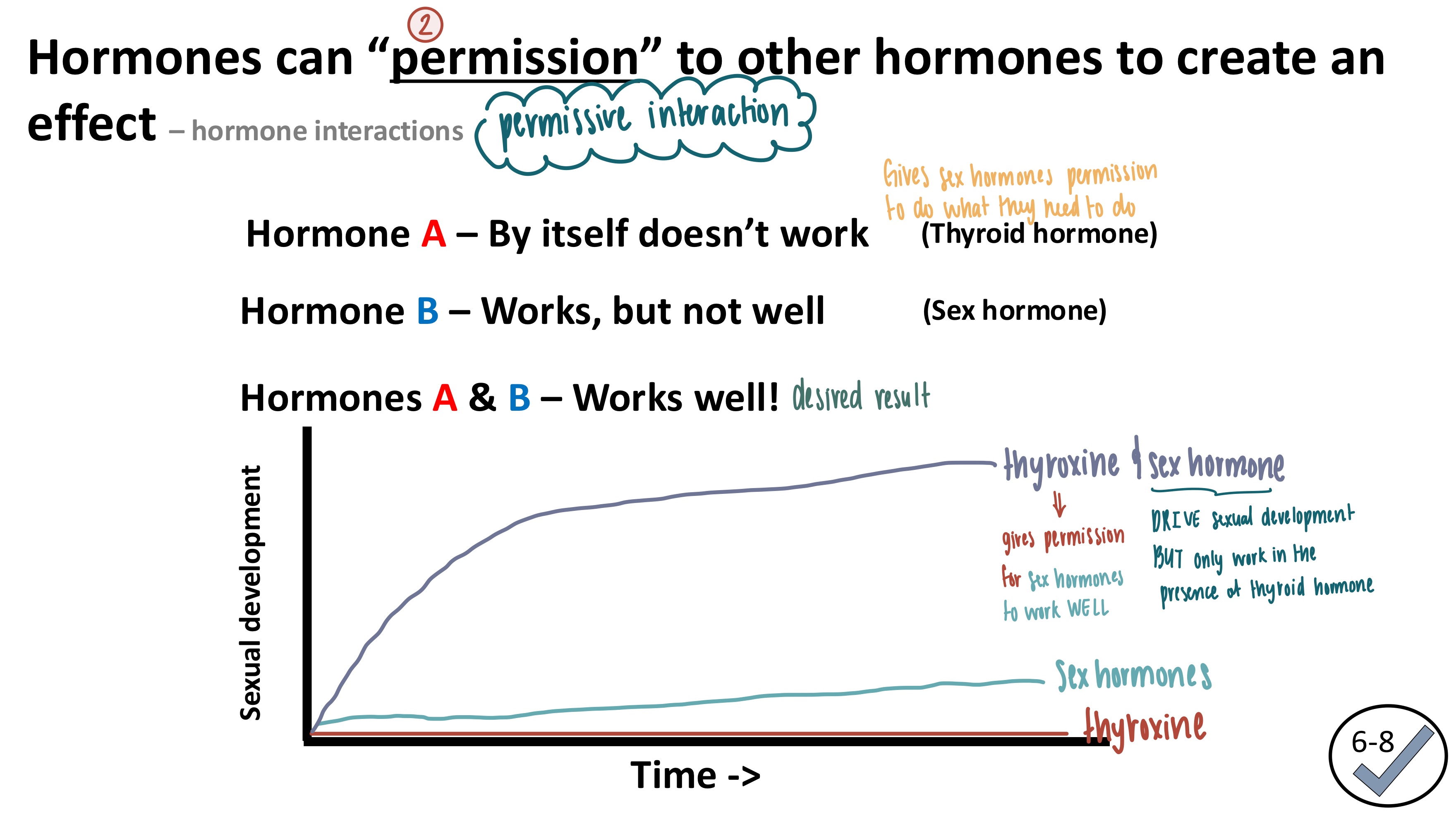
Syngeristic Hormone Interaction
When multiple hormones come together, they can amplify their effect
These common hormones have a common RESPONSE/EFFEt, they all do the same thing (they don’t give each other permission)
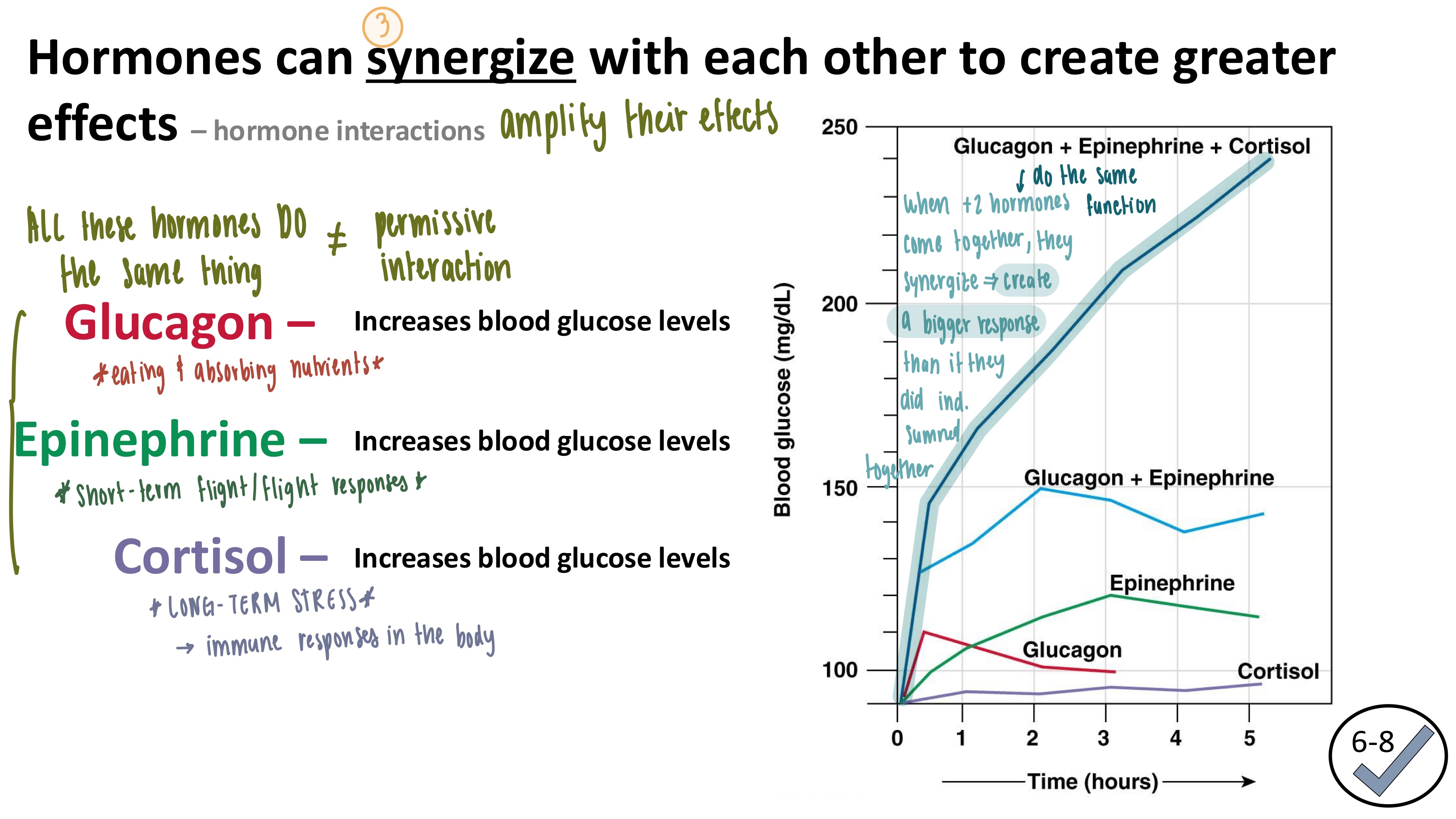
What are the 3 hormone interactions?
Antagonistic
Permissive
Synergistic